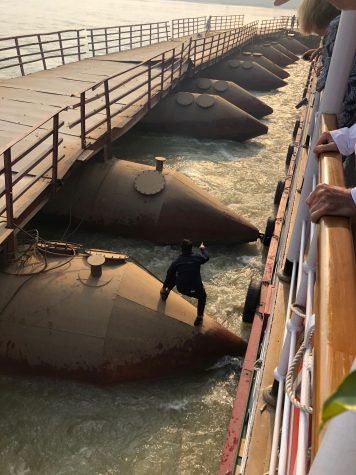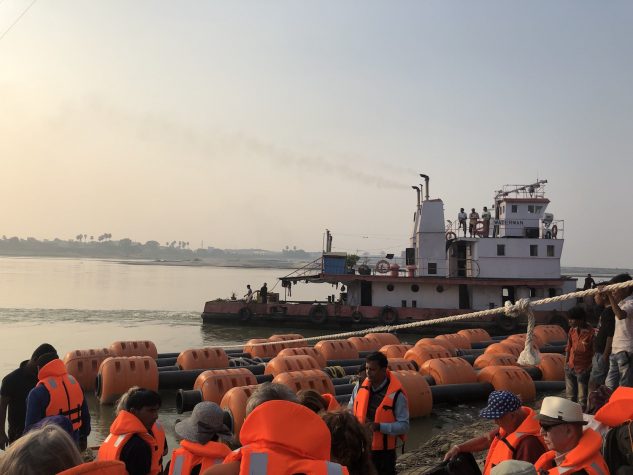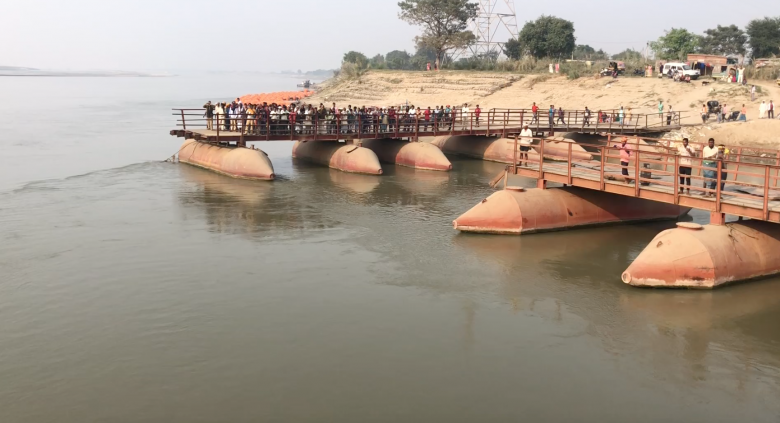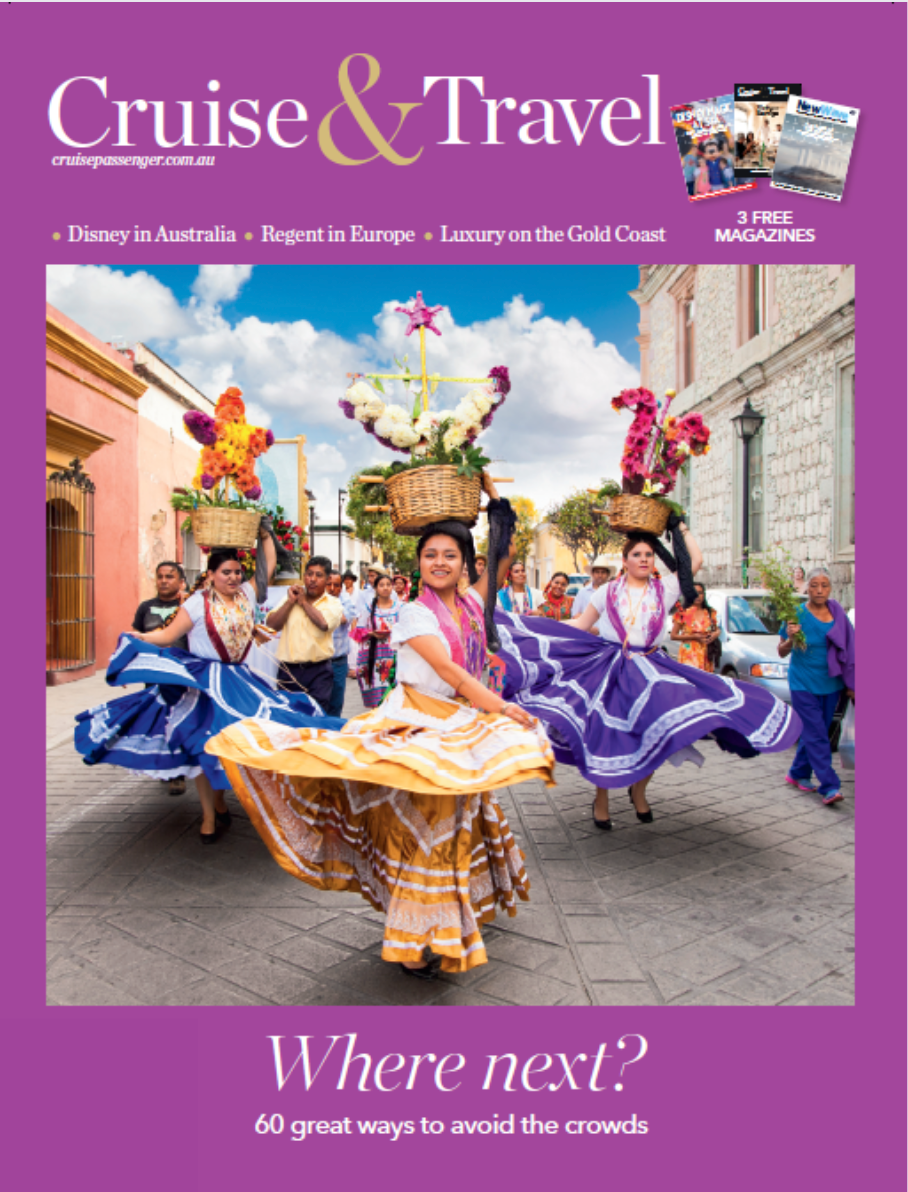How I ended up on the river bank after a nightmare India cruise
The scene was typical of India. Crowds of locals gathered to watch our riverboat, Kindat Pandaw, squeeze through a narrow gap in one of the eight seasonal pontoon bridges that line the Upper Ganges in low water.
Two sections of the bridge had unexpectedly been opened, road traffic backing up along the spindly structure. The current against us was ferocious, but all 24 of us were anxious to get through.
We were bored, frankly; the itinerary had been beset with delays and we’d been given one excuse after another. Not enough water. Too much current. Too dangerous to sail at night. But we couldn’t get through the bridges in the day as the local authorities wouldn’t open them.
As a result, we were already running two days late and the vision of sailing triumphantly into Varanasi with the only company prepared to attempt this in low water was fast fading.

The captain angled the boat at the gap and charged the ship through it, all engines revving. We cheered. The crowds standing on the pontoon, waiting to cross once the bridge closed again, cheered and waved.
Suddenly, I saw people on the bridge running in a panic; really fleeing. The bridge itself was actually moving. To my horror, I noticed that the aft port side of the boat had caught the bridge, and was dragging it along with a horrendous grinding, clanking sound. The next few seconds flew by in a panic, everybody on board shouting ‘Hold on!’ and bracing for impact as we were swept, port side, onto the bridge.
With a jolt, we ground to a halt. I was shaking. We peered over the railing and realised that the ship was pinned against the pontoons, which had pointed ends – and it looked as though one just under my cabin had holed the boat.
Our head guide, Debu, sprung into action, shouting at everybody to grab their lifejackets and get on the tender. At this point, we didn’t know whether the boat was sinking.
I stuffed my passport, laptop and camera into my rucksack and clambered on board. We were ferried to a sandy bank, where we stood in a forlorn little group. Because the ship was resting at an angle on the pontoons, the stern was lower than the bow and we were pretty convinced at that point that she was going down. Wistfully, I imagined my clothes being swept away down the turbulent river.

I embrace the travel challenges thrown out by India but this certainly wasn’t what I had envisaged when I signed up for this new itinerary, sailing all the way from Kolkata to Varanasi at a time when deeper draft ships simply couldn’t negotiate the shallow river.
I was amazed, then, when Paul Strachan, founder of Pandaw Group, said in a media statement: “At no point were passengers at risk and they were disembarked only as a precaution. On Pandaw remote-river expeditions, such adventures are part of the course [sic] and part of the adventure.”
Seriously? I’m sorry, but this was not par for the course, assuming that’s what Mr Strachan meant.

Three tugs arrived and hauled the boat off the pontoon, sending it spinning in the current and colliding with a large orange barrage that was being stashed on the beach where we were standing before correcting itself. The hull had been holed on the port side, as well as cracked.
It’s not what happened in the end, but what could have happened. Several passengers could only walk with sticks. The oldest on board was 89. The current was incredibly strong and slipping into the water would almost certainly been fatal.
We stood on the sandbank till dark, mosquitoes emerging in the dusk. Eventually, we were allowed to walk along the bank in the blackness to where the ship was tied up, to pack our things. After a quick dinner, we were ferried to a hotel. The river part of our journey was clearly over.
I posted the story on social media and was sent, privately, a picture of a different Pandaw vessel, Sabaidee Pandaw, listing against a bank on the upper Mekong in Laos, having hit a rock, with a message: “It’s concerning.”
Are river cruise lines testing more adventurous routes to mark themselves out from the usual Amsterdam to Budapest bus route?

The crash aside, Pandaw’s new itinerary was not working. The crew apparently had no knowledge of the pontoon bridges, which are put up seasonally when the river is low enough. Given that we could only cross at night, briefly, as night sailing wasn’t permitted for our boat, we would never have made Varanasi with six more bridges to cross.
Because we were late, excursions were either missed or involved hideous bus journeys. A trip to Nalanda and Bodhgaya, two important Buddhist sites in Bihar state, took 17 exhausting hours.
Brett Lemish, country manager for Pandaw in India, told me: “Following the events of this week, we are looking at reviewing our itineraries. It will have to be a combination of land and cruise, so we are looking at making the first or last three nights in Varanasi a hotel stay. When the river can flow properly, we will sail all the way from Varanasi to Kolkata. In February it starts to get better and the water levels go up.
“There is a whole conflict of what we had been promised by the Inland Waterways Authority of India. They had promised us depth – they were supposed to dredge the channel – and they had promised to open the pontoon bridges. Pilots and tugs are supposed to be surveying the river regularly so that they can direct us to the appropriate channels. The pontoons are supposed to be coordinated so that we arrive at a certain time and they open.
“We were not told when the itineraries were designed that they would only open at night.”

But there’s a difference between an adventurous expedition and poor planning. Speaking to the UK’s Sunday Times travel section, Strachan reiterated his point. “This was a very minor bump and the inexperienced crew overreacted and got all the passengers off, to my shock and horror. But they erred on the side of caution.
“We have collisions almost daily. That happens when you’re running 18 ships on six rivers. This is a brand-new destination for us, and always, in the first couple of seasons, things don’t go to plan.”
Was Strachan right? And would you sail on a relatively untested itinerary and take whatever the journey threw at you? Let us know.
Sue Bryant is a highly experienced cruise writer, our European editor and Cruise Editor of the Sunday Times in London.

